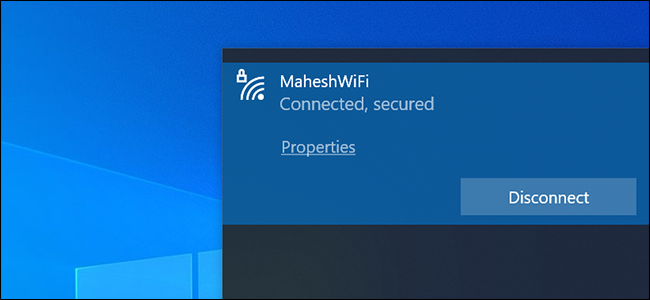If you’re having issues with your Wi-Fi connection, the strength of your Wi-Fi signal may be poor.There are many different ways to check your Wi-Fi signal strength in Windows 10 to find out how good or bad the signal quality is.
Use the Taskbar for a Quick Answer
Your PC’s taskbar (the bar at the bottom of the screen) has several icons on it. One of these is for your wireless networks, and you can use this icon to find your Wi-Fi signal strength.
To do this, click the wireless icon on your taskbar. It appears in the notification area to the left of the clock.
Note: If you don’t see the wireless icon, the taskbar might have hidden it. Click the up-arrow icon on the taskbar to reveal all hidden icons.
Find your Wi-Fi network in the list. It’s the network that Windows says you are “Connected” to.
You’ll see a small signal icon next to your Wi-Fi network. This icon represents the signal strength of your network. The more bars this icon has, the better your Wi-Fi signal is.
Tip: If you’re wondering how the strength of your Wi-Fi signal changes in different places throughout your home or another building, you can walk around with a laptop and see how the signal changes in different areas. The strength of your signal depends on many factors, including the placement of your router and where you are located relative to it.
RELATED: How To Get a Better Wireless Signal and Reduce Wireless Network Interference
You can also check the signal quality of other Wi-Fi networks using this menu. Just look at the signal icon for any network.
Or, Check the Settings App
The Settings app displays the same taskbar-like bars for your Wi-Fi signal strength.
To use this method, open the “Start” menu, search for “Settings,” and click the app in the results. Alternately, press Windows+i to quickly launch the Settings app.
In Settings, click “Network & Internet,” as this contains your wireless network information.
Here, under the “Network status” section, you’ll see a signal icon. This icon shows your current Wi-Fi network’s signal strength. Again, the more bars that this icon has, the better your signal is.
Use the Control Panel for More Accuracy
Unlike the Settings app and Windows taskbar, the Control Panel shows a five-bar icon for your Wi-Fi signal quality, which provides you with a more accurate answer.
To get to that signal icon, launch the “Start” menu, search for “Control Panel,” and click the utility in the results.
Here, click “Network and Internet.”
Click “Network and Sharing Center” on the right pane.
You’ll see a signal icon next to “Connections” that shows the quality of your current Wi-Fi signal. The more bars that are highlighted in this icon, the better your signal is.
Use Windows PowerShell for Precision
The methods above only give you a rough idea of your Wi-Fi network’s signal strength. If you need a more precise answer, you should use Windows PowerShell.
The netsh command built into Windows 10 shows your network’s signal strength in percentage form, which is much more accurate than any of the other methods listed in this guide.
To get this accurate answer for your network, access the “Start” menu, search for “Windows PowerShell,” and click the PowerShell app shortcut in the results.
Copy the following command from here and paste it into your PowerShell window. Press “Enter” to run the command.
(netsh wlan show interfaces) -Match '^s+Signal' -Replace '^s+Signals+:s+',''
PowerShell only displays a single line output, which shows your current Wi-Fi signal strength in percentage form. The higher the percentage is, the better your signal is.
To view more information about your network (such as the network channel and the connection mode), run the following command:
netsh wlan show interfaces
Or, Use Command Prompt
You can also run the netsh command in a Command Prompt window if you prefer that interface. In its full form, the command also shows more details about your network, like the SSID (network) name and the authentication type.
To begin, open the Command Prompt by launching the “Start” menu, searching for “Command Prompt,” and clicking the utility in the results.
In your Command Prompt window, type the following command and press “Enter.”
netsh wlan show interfaces
The output displays much more information than what you’re looking for here, so look toward the field that says “Signal.”
The percentage next to “Signal” is your Wi-Fi signal strength.
If these methods indicate that your Wi-Fi signal strength is poor, one way to improve the signal quality is to bring your devices and routers closer to each other. Also, make sure that there are no hard objects (like a wall, for example) between your router and your devices. These objects often hinder the quality of your Wi-Fi signal.
There are other methods that allow you to check your Wi-Fi network’s signal strength more precisely. You may want to use one of those methods if the measurements above don’t work for you, or if you’d prefer to check signal strength using an iPhone, iPad, Android device, or Mac.

















